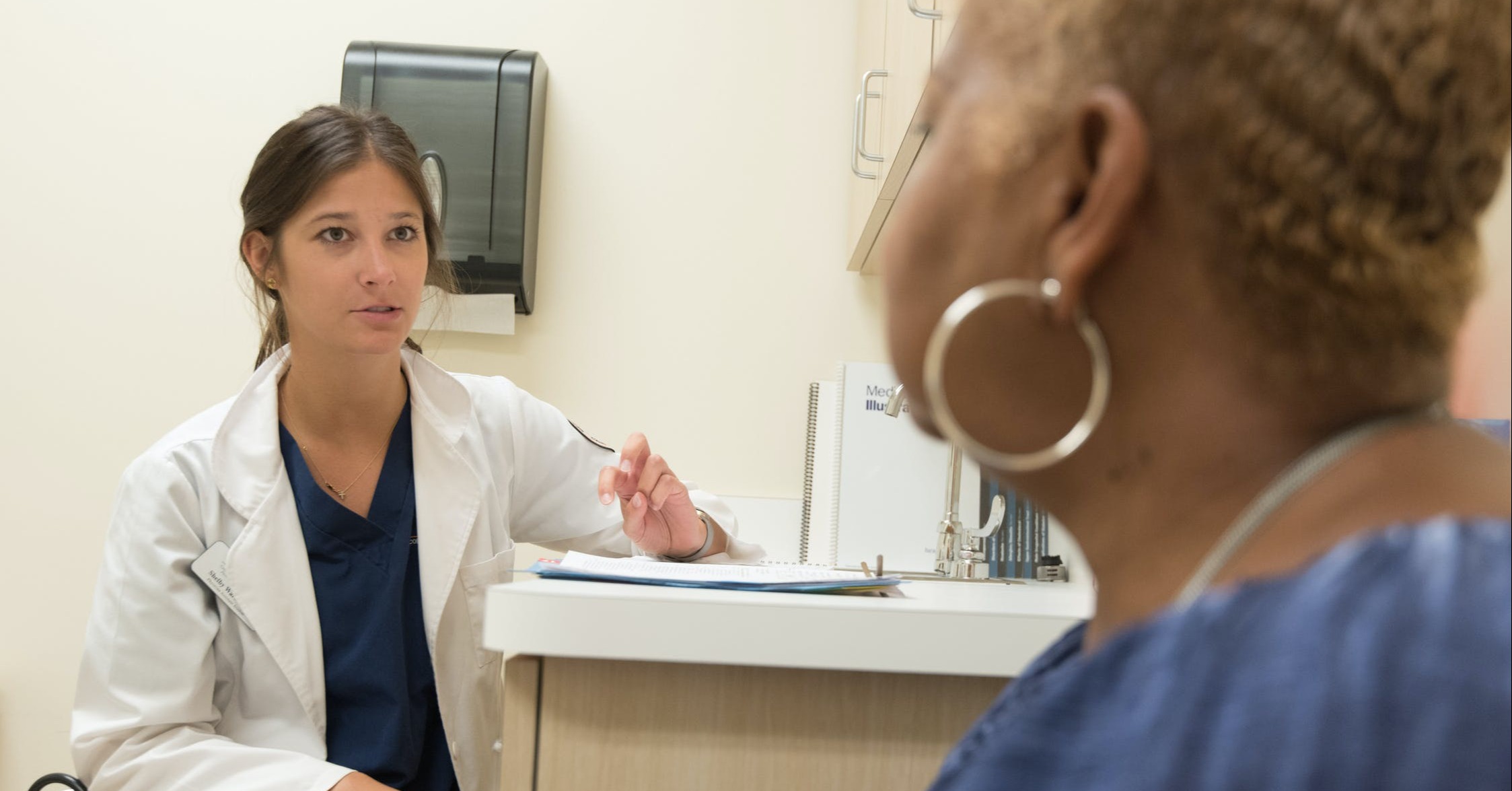
Physician Assistant vs. Doctor: What Is the Difference?
Physician assistants diagnose and treat patients, prescribe medication, and perform [...]

With the incidence of skin cancer on the rise worldwide, the medical community is experiencing a concurrent rise in demand for dermatologists, an increase of about 30 percent according to the US Bureau of Labor Statistics (BLS). The need is immediate, but the solution isn’t: the path to dermatology practice requires about 12 years of schooling (undergraduate and graduate) and training.
There is another option: becoming a dermatology physician assistant requires only a bachelor’s degree and a master’s degree (earned through a physician assistant program). Others have discovered this route, and they like what they’ve found. Glassdoor reports high demand for physician assistants, calling it one of its top 50 jobs in America in 2021 based on median salary, job growth, and overall job satisfaction.
You won’t earn as much money as a dermatologist when you become a dermatology physician assistant, but you will get to start practicing earlier in your career—and you’ll enjoy the same satisfaction of helping patients maintain the health of their largest organ.
In this article, we’ll cover:
Dermatology PAs work closely with supervising doctors and can perform many of the same duties. On the downside, they earn less than dermatologists while facing many of the same stresses and long work hours. Before you decide that a dermatology specialty is for you, consider these pros and cons:
According to PayScale, dermatology PAs earn an average of $101,379 per year.
You’ll perform many of the same duties as a doctor without having to complete medical school (PAs have a bachelor’s degree and a master’s degree).
As a dermatology medical assistant, you’ll help people feel confident, treat skin issues, and even detect and treat cancer.
A physician assistant role in dermatological care generally requires a team effort. You’ll work with a care team, including attending physicians, nurse practitioners, and other healthcare professionals.
Although you will make a good salary as a PA, you’ll make much less than your supervising physician while doing very similar work.
Expect potentially long and odd hours, plus being on call at times.
It can be stressful to treat patients all day and always have to be “on.” Mistakes can be costly.
As a dermatology physician assistant, your duties will vary based on the specialization you choose. Dermatology specialties include:
Medical dermatology is a necessary specialty. These professionals combine internal medicine and dermatology to “treat difficult, rare, or complex skin conditions that may be the result of an internal medicine disease, systemic disease, autoimmune disease, or contact dermatitis (skin allergy),” according to Weill Cornell Medicine.
These dermatologists specialize in removing growths and cancers. They perform Mohs surgery to eliminate skin cancer and also can conduct facial reconstruction after treatment.
Pediatric dermatologists specialize in working with children who can experience many of the same conditions as adults.
Elective dermatology includes procedures like chemical peels, laser treatments, and removing varicose or spider veins.
According to the Academic Alliance in Dermatology, “Dermatopathology combines dermatology with pathology, or the study and identification of diseases using samples of hair, skin, etc.”
Dermatoimmunology is the process of testing blood, serum, and tissue for diseases.
As a dermatology PA, you’ll perform many of the same tasks as medical doctors (MD) and doctors of osteopathic medicine (DO). Depending on your specialty, you’ll work in a dermatology office, hospital, or private practice.
Common job duties include:
This includes consulting with patients, monitoring their progress, and even prescribing medication.
PAs are allowed to order and interpret tests. That means they can diagnose and treat skin conditions such as eczema, acne, rosacea, psoriasis, and even cancer.
PAs can assist doctors with surgery, even if they cannot perform it independently. That said, they can perform procedures like biopsies for cancer screenings, botox injections, executing chemical peels, tattoo removals, and more.
Many years of medical school aren’t for everyone; that’s why some students choose to become PAs, which requires just six years of school. You’ll spend four years earning your bachelor’s degree and two years of PA school pursuing your master’s degree (MPAS).
You can major in whatever undergraduate field you choose. However, you’ll need to complete undergraduate-level science courses, including chemistry, biology, anatomy, and physiology, microbiology. Many programs also have minimum GPA requirements, typically between 2.75 and 3.2, according to the AAPA.
It’s essential to have previous health care experience before applying to a program, usually three years worth. Standard job titles for applicants include emergency medical technician (EMT), Peace Corps volunteer, lab assistant, and registered nurse.
Most graduate school applicants take the GRE. Naturally, top schools look for better scores. According to the Educational Testing Service (ETS), average scores on the 2021-2022 test for in the physical sciences were verbal reasoning (151), quantitative reasoning (160), analytical writing (3.6).
Graduate programs usually require at least two letters of recommendation, often from former employers or professors. These letters should showcase your abilities and work ethic.
The personal essay (or essays) allows you to write about why you want to be in the program and why you’d fit. Personal essays can also allow you to explain a deficiency in your application, such as a rough academic semester.
Most dermatology physician assistants earn a Master of Physician Assistant Studies with a concentration in dermatology. Not all MPAS programs offer this concentration, so you should study the curriculum of each program you consider closely before applying. Your MPAS program will train you in varied fields, including emergency medicine, primary care, and family medicine. You’ll need to enroll in an accredited physician assistant program that includes clinical rotations.
After completing your clinical rotations and master’s degree from an accredited PA program, you need to pass the Physician Assistant National Certifying Examination (PANCE) to become certified through the National Commission on Certification of Physician Assistants. Once you have passed the exam, you can add the letters PA-C to your title.
All physician assistants must also be licensed to practice in their state (and requirements vary by state). Once you’re ready to search for a job, you’ll find that most dermatology offices are located in more populated areas. Relocating to a city or large town might be necessary for your career.
Joining a professional organization as you complete your physician assistant studies will not only give you invaluable resources to become a dermatologist assistant, but it can also help boost your PA resume and professional development. Two of the most respected organizations to join are the American Academy of Physician Assistants (AAPA) and the Society of Dermatology Physician Assistants (SDPA). These organizations provide access to conferences, education, training, networking, job postings, and more. Potential employers and patients alike look for membership in professional organizations when checking out physician assistants.
A general dermatology internship can strengthen your resume and improve your skills. You’ll study a broad overview of many specialties when you complete your clinical rotations during physician assistant education. Focusing on dermatology will help you stand out when it’s time to look for a job. This is also a good chance to network with a supervising physician, hone your skills, and potentially open the door to a full-time job.
You’ll learn a lot from your supervising dermatologist in your first few years on the job. If you want to further your training before entering the workforce, there are residency programs for PAs. Although a dermatology residency program is not necessary, it can increase your confidence, skills, and employability.
Physician assistant salaries are typically around $110,000 per year, and tend to increase the longer you work in the field. These are a few of the highest paying jobs in the United States. Many PAs get paid a flat salary; others earn a flat salary plus a portion of the practice’s earnings.
Besides your formal schooling, you will need to complete 100 hours of continuing medical education (CME) every two years. After you sit for your PANCE, you’ll also need to take a recertification exam every 10 years.
Think becoming a dermatology physician assistant is right for you? If you’re ready for a challenging career where you help people feel better about their skin, improve painful skin conditions, and even help save lives by detecting and treating cancer, it may well be. Added bonus: you’ll be one of the few people who can say “I saved your skin” to someone and mean it literally, not just figuratively.
(Updated on January 19 2024)
Questions or feedback? Email editor@noodle.com

Physician assistants diagnose and treat patients, prescribe medication, and perform [...]

While online physician assistant programs do not offer virtual clinical [...]

Physician assistants diagnose, treat, and counsel patients, just as doctors [...]

Physician assistants must pass the National Commission on Certification of [...]

he prerequisites for admission to a physician assistant master's program [...]
Categorized as: Physicians Assistant Studies, Nursing & Healthcare